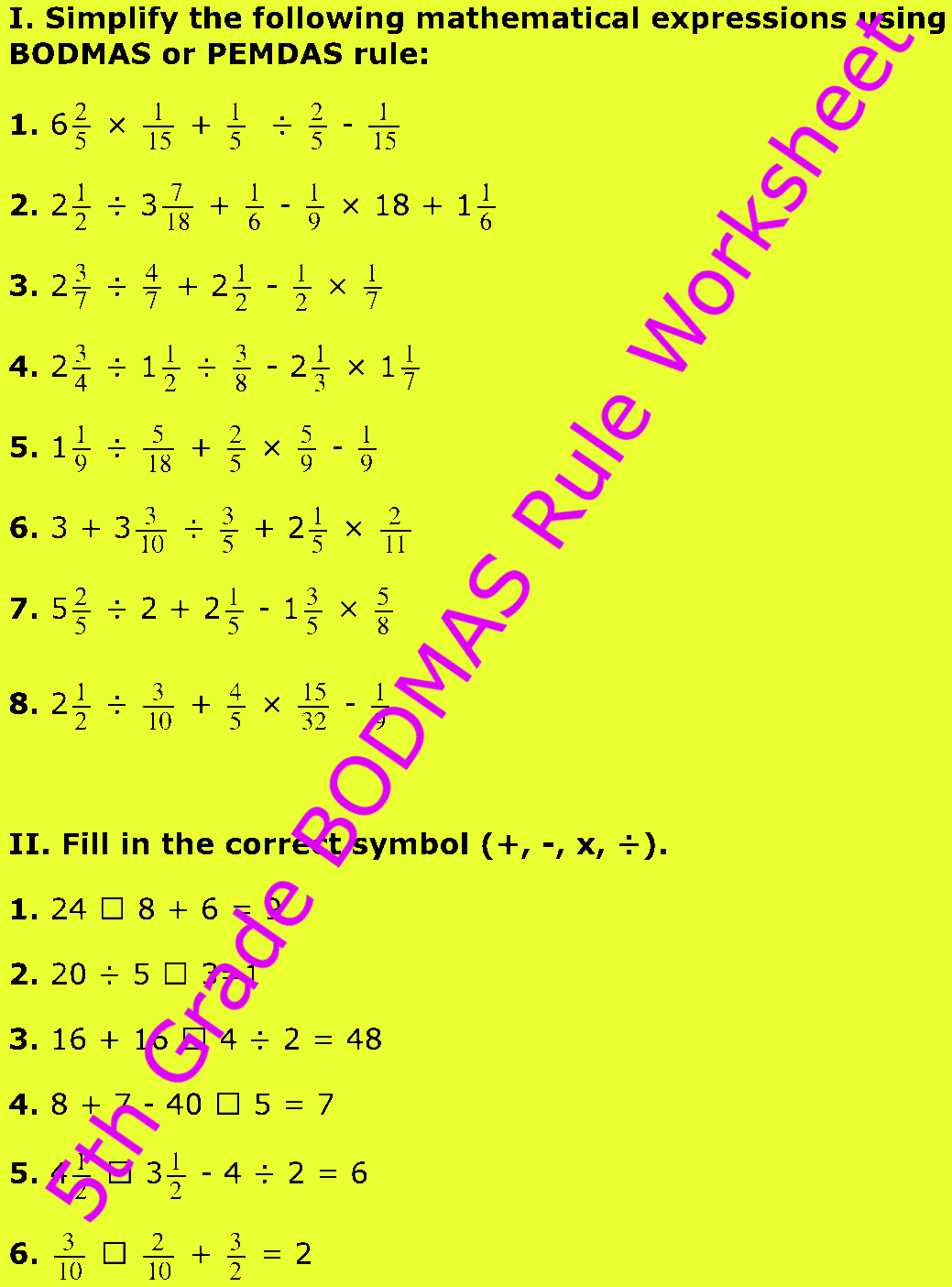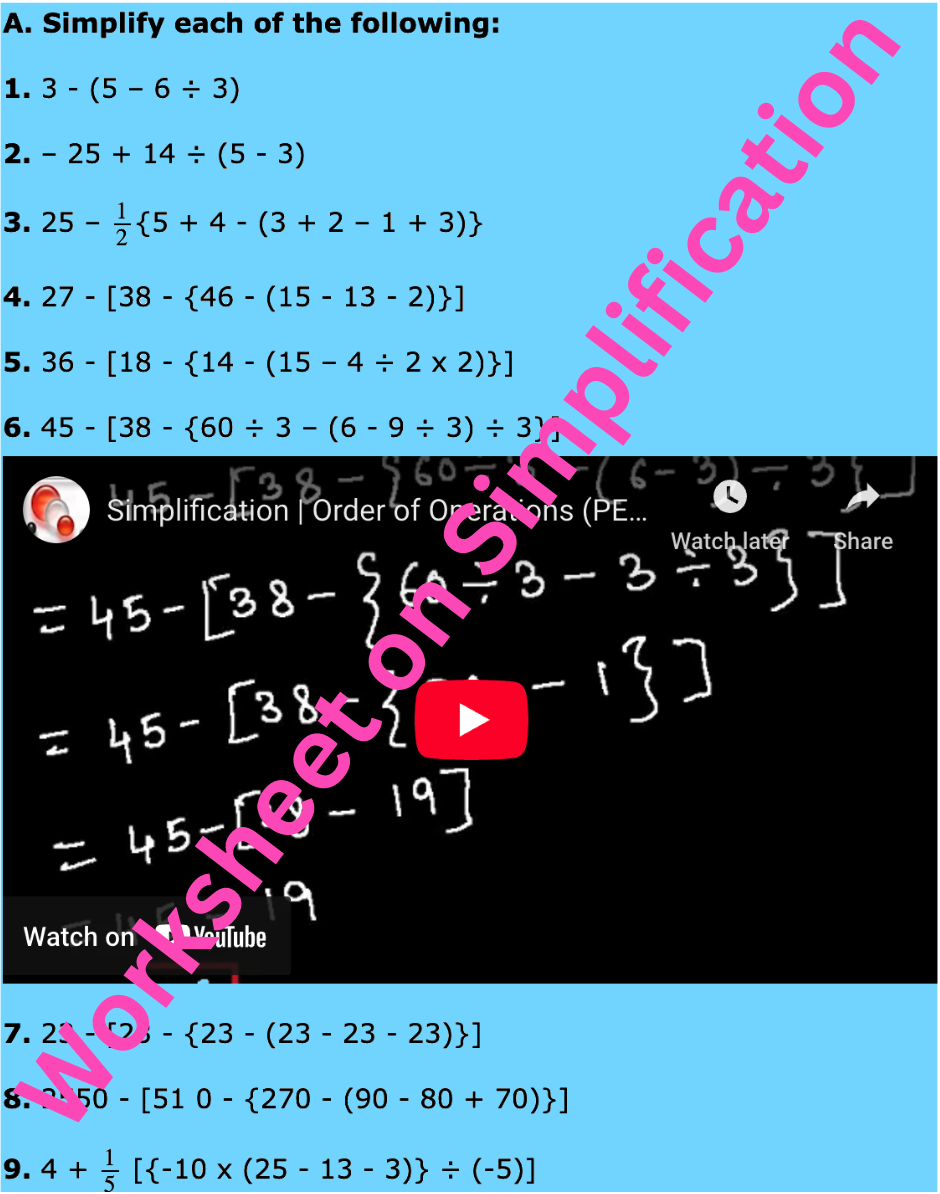Sign of the Quadratic Expression
We already acquainted with the general form of quadratic expression ax^2 + bx + c now we will discuss about the sign of the quadratic expression ax^2 + bx + c = 0 (a ≠ 0).
When x be real then, the sign of the quadratic expression ax^2 + bx + c is the same as a, except when the roots of the quadratic equation ax^2 + bx + c = 0 (a ≠ 0) are real and unequal and x lies between them.
Proof:
We know the general form of quadratic equation ax^2 + bx + c = 0 (a ≠ 0) ..................... (i)
Let α and β be the roots of the equation ax^2 + bx + c = 0 (a ≠ 0). Then, we get
α + β = -b/a and αβ = c/a
Now, ax^2 + bx + c = a(x^2 + b/a x + c/a)
= a[x^2 - (α + β)x + αβ]
= a[x(x - α) - β(x - α)]
or, ax^2 + bx + c = a(x - α)(x - β) ..................... (ii)
Case I:
Let us assume that the roots α and β of equation ax^2 + bx + c = 0 (a ≠ 0) are real and unequal and α > β. If x be real and β < x < α then,
x - α < 0 and x - β > 0
Therefore, (x - α)(x - β) < 0
Therefore, from ax^2 + bx + c = a(x - α)(x - β) we get,
ax^2 + bx + c > 0 when a < 0
and ax^2 + bx + c < 0 when a > 0
Therefore, the quadratic expression ax^2 + bx + c has a sign of opposite to that of a when the roots of ax^2 + bx + c = 0 (a ≠ 0) are real and unequal and x lie between them.
Case II:
Let the roots of the equation ax^2 + bx + c = 0 (a ≠ 0) be real and equal i.e., α = β.
Then, from ax^2 + bx + c = a(x - α)(x - β) we have,
ax^2 + bx + c = a(x - α)^2 ................ (iii)
Now, for real values of x we have, (x - α)^2 > 0.
Therefore, from ax^2 + bx + c = a(x - α)^2 we clearly see that the quadratic expression ax^2 + bx + c has the same sign as a.
Case III:
Let us assume α and β be real and unequal and α > β. If x is real and x < β then,
x - α < 0 (Since, x < β and β < α) and x - β < 0
(x - α)(x - β) > 0
Now, if x > α then x – α >0 and x – β > 0 ( Since, β < α)
(x - α)(x - β) > 0
Therefore, if x < β or x > α then from ax^2 + bx + c = a(x - α)(x - β) we get,
ax^2 + bx + c > 0 when a > 0
and ax^2 + bx + c < 0 when a < 0
Therefore, the quadratic expression ax^2 + bx + c has the same sign as a when the roots of the equation ax^2 + bx + c = 0 (a ≠ 0) are real and unequal and x does not lie between them.
Case IV:
Let us assume the roots of the equation ax^2 + bx + c = 0 (a ≠ 0) be imaginary. Then we can take, α = p + iq and β = p - iq where p and q are real and i = √-1.
Again from ax^2 + bx + c = a(x - α)(x - β) we get
ax^2 + bx + c = a(x - p - iq)(x - p + iq)
or, ax^2 + bx + c = a[(x – p)^2 + q^2] .....................(iv)
Hence, (x - p)^2 + q^2 > 0 for all real values of x (Since, p, q are real)
Therefore, from ax^2 + bx + c = a[(x - p)^2 + q^2] we have,
ax^2 + bx + c > 0 when a > 0
and ax^2 + bx + c < 0 when a < 0.
Therefore, for all real values of x from the quadratic expression ax^2 + bx + c we get the same sign as a when the roots of ax^2 + bx + c = 0 (a ≠ 0) are imaginary.
Notes:
(i) When the discriminant b^2 - 4ac = 0 then the roots of the quadratic equation ax^2 + bx + c = 0 are equal. Therefore, for all real x, the quadratic expression ax^2 + bx + c becomes a perfect square when discriminant b^2 -4ac = 0.
(ii) When a, b are c are rational and discriminant b^2 - 4ac is a positive perfect square the quadratic expression ax^2 + bx + c can be expressed as the product of two linear factors with rational coefficients.
11 and 12 Grade Math
From Sign of the Quadratic Expression to HOME PAGE
Didn't find what you were looking for? Or want to know more information about Math Only Math. Use this Google Search to find what you need.
Recent Articles
-
Counting Numbers from 1 to 50 | Match the Number | Missing Numbers
Apr 04, 25 03:46 PM
In counting numbers from 1 to 50, recognize the numbers, count and then join the numbers in the correct number order. Here we mainly need eye-hand coordination to draw the picture and maintain the num -
Counting Eleven to Twenty with Numbers and Words |Numbers from 11 - 20
Apr 04, 25 03:21 PM
Counting eleven to twenty with numbers and words are explained below. One ten and one more is eleven. Eleven comes after ten. One ten and two more is twelve. Twelve comes after eleven. -
5th Grade BODMAS Rule Worksheet | PEMDAS | Order of operations|Answers
Apr 03, 25 03:11 PM
In 5th Grade BODMAS Rule Worksheet you will get different types of problems on mathematical expressions involving different operations, mathematical expression with 'brackets' and 'of' and simplifying… -
Worksheet on Simplification | Simplify Expressions | BODMAS Questions
Apr 03, 25 02:58 PM
In worksheet on simplification, the questions are based in order to simplify expressions involving more than one bracket by using the steps of removal of brackets. This exercise sheet -
Divisible by 2 Video |Test of Divisibility by 2 Trick| Rules| Examples
Apr 03, 25 10:25 AM
A number is divisible by 2 if the digit at unit place is either 0 or multiple of 2. So a number is divisible by 2 if digit at its units place is 0, 2, 4, 6 or 8.





New! Comments
Have your say about what you just read! Leave me a comment in the box below. Ask a Question or Answer a Question.